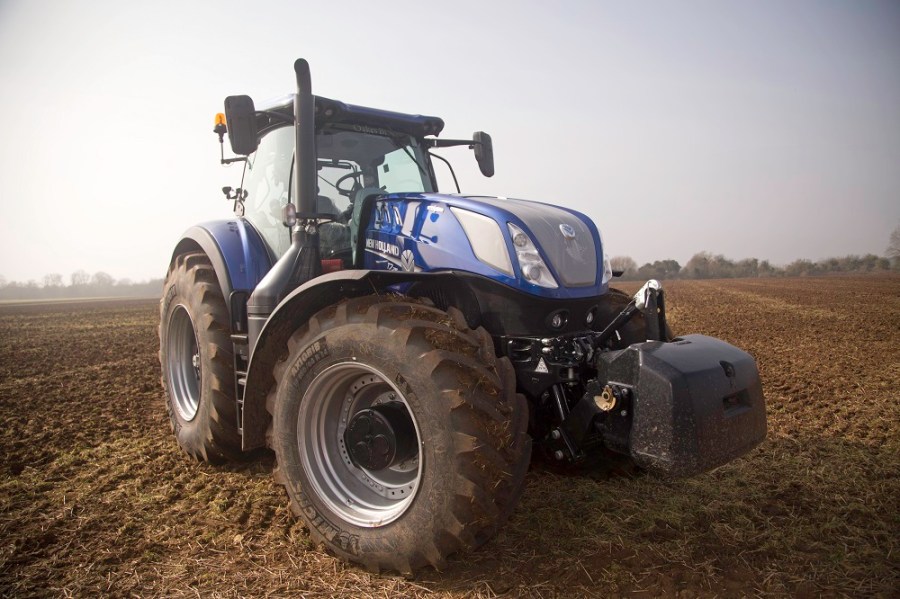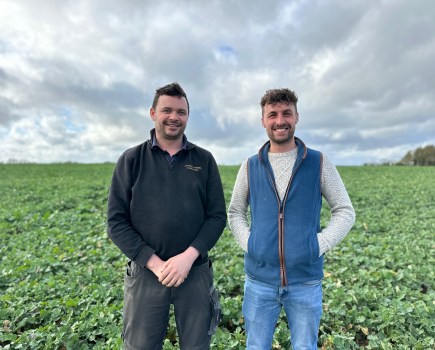When a Surrey contractor took on a pre-production T7 HD tractor from New Holland they found the step-up in stature and more muscle it offered gave a boost to productivity, and more besides. CPM calls in for the full verdict.
We want machines that can be treading gently with a fertiliser spreader one minute and then switching across to traction-hungry heavy cultivations the next.
By Nick Fone
Last year, Surrey farmer and contractor Edward Ford had the chance to run a pre-production version of New Holland’s HD-badged T7-series tractors, putting it through its paces on mowers, balers, drills and haulage duties.
A truly mixed farming business, Ford Farms extends to some 750ha of arable cropping plus another 465ha of grazing and forage leys to support a 1200-head beef-finishing enterprise. In addition to that, Edward Ford undertakes a range of contracting operations which includes baling and wrapping as well as all arable operations.
With such a workload, the firm runs a fleet of six tractors – all Basildon blue – from a monster 550hp T9.560 artic. to a much more modest 127hp T6050. The blue hue has long been a feature at Lodge Farm near Dorking and so the business was considered ideal by New Holland to make a true assessment of its new load-lugger’s abilities.
More muscles
The two T7 Heavy Duty (HD) models are an extension of the company’s existing T7 range – bigger in stature, heavier on the scales and with more muscle under the bonnet than standard versions. With the T7.290 HD rated at 270hp and the T7.315 HD at 300hp, they push the power boundary of a relatively compact chassis range into new territories, clearly aimed to compete with the likes of Fendt.
At 10.5t, they’re 2.35t heavier than the previous range-topping, long-wheelbase T7s and 11cm longer to aid in stability. That’s required because the rear linkage will now hoist 6% more load (up to 11,058kg). The new tractors can also be fitted with some serious rubber, up to 900mm wide on 42in rims.
The two new HD models mean the T7 range now runs from 140hp right up to 300hp with three different chassis sizes – standard, long wheelbase and heavy duty (HD) – a total of 10 different models.
So what’s different about the two new range toppers apart from their extra grunt and bulk?
The engine is much the same as before. As with previous T7s, the new HD variant uses an Iveco-derived 6.7-litre Fiat Power Train six-cylinder power-plant, kitted out with the latest emissions-limiting gubbins to make it Tier 4B compliant – boring but necessary. More importantly from an operator’s point of view, it has a big electronically controlled variable output turbo to create low end torque. Where previously there was a boost function that kicked in for transport and pto work as well as certain hydraulic applications, the new models deliver max power whenever it’s required.
The engine also has a special structural sump purpose-designed for the two HD models to cope with the higher stresses while not limiting front-wheel turn angle.
In the transmission department, like the biggest standard and long-wheelbase models, the HDs are only available with a stepless AutoCommand CVT gearbox – built at CNH’s Antwerp factory and shared with sister-company Case IH. Key differences on the flagship models are a higher input speed to cope with the higher power and torque loadings and upgraded control software.
So how did the pre-production machine perform while under evaluation with Ford Farms?
In its short stay in Surrey, the T7.315 HD had a varied workload, kicking off with a front and rear mower-conditioner combination and then moving onto a New Holland BB870 square baler. It was throughout harvest it clocked the majority of its 400 hours with an 18t Stewart trailer before rounding off the season coupled up to a 6m Väderstad
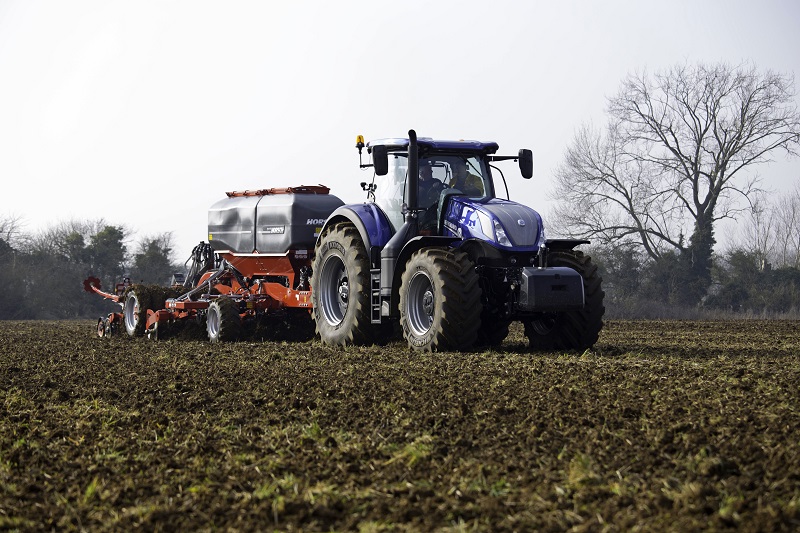
With the T7.290 HD rated at 270hp and the T7.315 HD at 300hp, they push the power boundary of a relatively compact chassis range into new territories.
Photo courtesy Nick Barlow
Rapid drill.
“With our contracting work, cattle and arable acreage we always have a fair bit on and we need tractors that are capable of swapping from job to job,” explains Edward Ford.
“It’s a big ask but ideally we want machines that can be treading gently with a fertiliser spreader one minute and then switching across to traction-hungry heavy cultivations the next. I had big hopes for the HD as it looked like it promised to offer the best of all worlds.
Underpowered
“Our biggest conventional tractor is currently a T7.270 which, despite what it says on the bonnet, is really only rated at around 230hp. In truth, it’s a bit underpowered for some of our work, particularly where we’re cultivating and drilling on some of our steepest ground.
“When you fill our 6m Rapid with seed and the ground’s a bit tacky, the 270 really knows about it and it’s the same
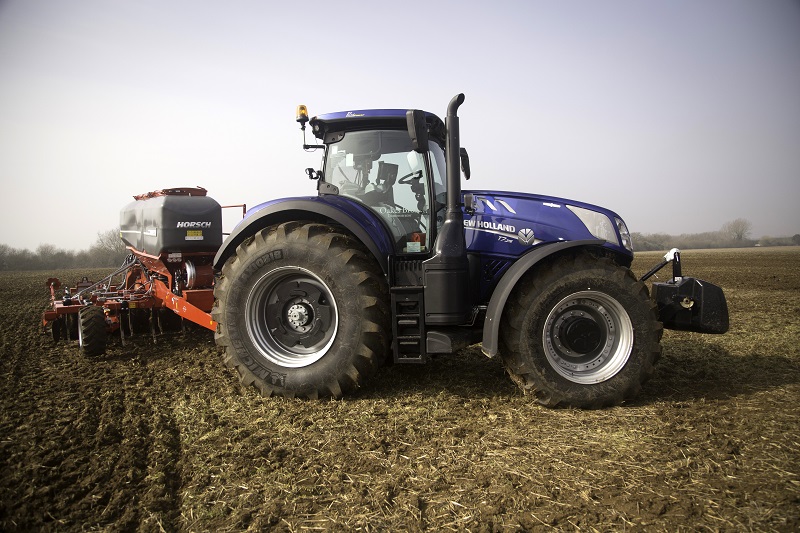
The new tractors can be fitted with some serious rubber, up to 900mm on 42in rims, which put a firm footprint of at least four lugs to the soil on each wheel.
Photo courtesy Nick Barlow
story with our 4.6m Simba SLD. Likewise if you load up our 18t trailers to the max you need all that power and more on our steep hills.”
Equipped with front linkage and pto, the T7.315 HD arrived at Lodge Farm last June in time to start knocking down grass destined for the business’ haylage enterprise with the pair of mower-conditioners. That was no stretch for the amply powered tractor and it was a similar story when it came to hitching up the four-string BB baler.
“Pretty quickly the prototype proved that it was a completely different machine to our existing T7s. Despite having essentially the same engine, it absolutely walked away with the mowers and baler.
“And, because it was never struggling, it didn’t burn excessive amounts of fuel. In fact, it wasn’t using any more diesel than the 270.”
During harvest, the HD spent much of its time on haulage duties where, in addition to its impressive pulling power, a couple of additional unforeseen advantages came to light.
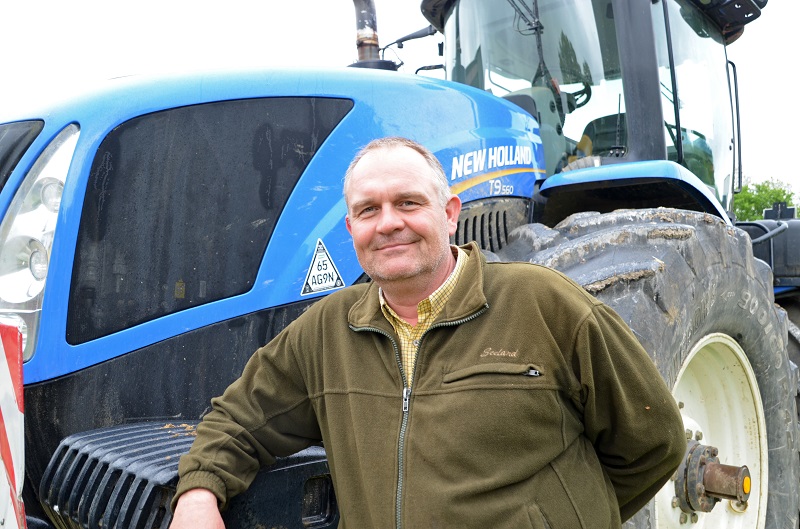
Edward Ford is true blue, through-and-through, and realised pretty quickly the prototype was a completely different machine to his existing T7s.
“Being considerably taller, visibility from the 315’s cab is so much better into our high sided trailers.
“It pulls incredibly but, being heavier, it also pulls up so much better on the anchors. The brakes are second-to-none. Having the new road rules allowing us to put bigger tractors on the front of the trailers makes so much more sense – we’re much safer.
“Once again on corn cart, the more powerful tractor wasn’t any more thirsty than our smaller machines.”
Pulling down ground
With crops cleared off the fields, the T7.315 was then put to work pulling down ground before going to work with the farm’s 6m Väderstad Rapid cultivator drill.
“Being a mixed farming business we tend to use a mix of different approaches to getting crops in the ground.
“We always tend to plough in front of winter barley and oats as it gives us a good opportunity to get on top of wheat volunteers and blackgrass. However, until last year, for everything else we’ve tried to stick with a minimum tillage approach, discing and pressing ahead of the drill.
“But with margins ever tight, last season we decided we had to start moving towards direct drilling and we took the plunge by buying an 8m Sumo DTS to go behind the 550hp T9 artic. It’s taken us a bit by surprise as the crops drilled with that have performed as well as those established with a more conventional approach.”
That standard regime involved the min-tilled ground being beaten into submission with a heavy press before the Rapid drill came in to do its stuff.
“To do a decent job with the Rapid you have to go as fast as you can while managing to stay in the seat. That way, the front rows of cultivator discs annihilate any knobbly bits and produce a good seedbed so long as it’s not too damp,” explains Edward Ford.
“But with our T7.270 we couldn’t always maintain those speeds so the surface finish would suffer. The 315 was a completely different beast – because the power is there all the time and you’re not waiting on a boost to kick in, it just kept going and wasn’t limited by traction.”
Having some serious rubber at each corner has significantly improved the HD’s in-field draft performance. 710/75R42s meant the pre-series machine was no wider on the road than the farm’s existing T7s but significantly taller, extending the tractor’s footprint to the point that there were at least four lugs in contact with the ground on each wheel.
“With such a big contact area, the HD doesn’t sink or even get close to spinning. There’s heaps of traction and no need to fit duals which are such a hassle that they are rarely used when they should be.
“Doing all sorts of cultivations work – from the 6.6m Simba Xpress to the 4.6m SLD – the combination of the phenomenal power, extra weight, longer chassis and bigger tyres means that the tractor is doing a better job all round.”
Fuel use
Again on the fuel front, the new machine doesn’t suffer the same issue that the smaller models have. With a 630-litre diesel tank, it can run all day on heavy cultivations work without requiring an early evening top up – another simple thing that means there’s no need to interrupt work when the pressure’s on.
Given that the T7.315 HD at Lodge Farm last season was a pre-production machine, it gave very little trouble.
“We had a few minor niggles but they were all computer-related problems and were quickly fixed by New Holland’s engineering team with software upgrades,” says Edward Ford.
“It wasn’t a surprise to us – the whole point of prototype testing is to give it real world work to identify any potential faults. That said, not once was the tractor parked up because it was broken.”
Last autumn the pre-series machine returned to New Holland’s research and development department at Basildon in Essex to be stripped and evaluated for how it fared after having been subjected to the strains and stresses of farm work. So this season the team at Ford Farms has fallen back to the T7.270 as its main front-line tractor.
“The 315 was such a step up and in truth was the perfect balance of weight, size and power for what we do – we’re missing it now.
“Sadly we weren’t due to change our big standard tractor this year but when we do the HD will be the front-runner.”
Tech specs – New Holland T7.315 HD
- Rated power: 221hp
- Max power: 230hp
- Engine: 6.7-litre FPT 6cyl with AdBlue
- Transmission: Stepless CNH AutoCommand CVT
- Hydraulics: 165 litres/min; 5x spool valves
- Max linkage lift: 11,058kg
- PTO: 540, 540E, 1000, 1000E
- Tyres: 710/75R42
- Turning circle: 11.4m
- Typical working weight: 10.5t-12.5t
- List price: £185,891
View from the tractor seat
Having spent 300-400 hours behind the wheel of one of New Holland’s pre-production evaluation T7.315 HDs last summer and again this spring, Colin Woodhams has a good idea of the new tractor’s strengths and weaknesses.
“The changes New Holland has made have clearly been thought through from a driver’s perspective,” he says.
“It’s small things like angling the spool-valve connectors downwards to make coupling up pipes easier and moving the ISOBUS plug from the inner mudguard to the centre to cater for different implements with different length cables. All the simple things add up to make the operator’s day-to-day jobs easier.”
Although these seemingly minor alterations may seem trivial, they all combine to make a vast overall improvement in Colin Woodhams’ opinion. But of course the real measure is how well the tractor fulfils its core load-lugging role.
“The 315 gives you pretty much what it says on the bonnet so you get all the power when you want it. There’s no boost to wait for and the difference is phenomenal.
“Given it’s almost the same engine, its power delivery is a revelation. The only time we really managed to drag it down was with the 6m Väderstad drill on some of our steeply banked ground.
“On haulage work, with a heavily laden 18t Stewart trailer, the prototype just continued on at whatever pace you chose. And the way it handles is fantastic – at 50km/h our other tractors can feel a little bit vague. With electronically-controlled self-centring power-steering, it drives like a car – it’s super precise.”
That extra element of precision is thanks in part to a redesigned Terraglide front axle which has twin dampers and accumulators to cushion shock-loads. The general consensus from the Surrey-based test team was that it’s a massive improvement over what has gone before.
It’s the same story with the redesigned stepless AutoCommand transmission.
“Over the past six years, I’ve had three New Holland tractors with CVT boxes which have been great but this new version is another step on again,” says Colin Woodhams.
“With the way the new software works, it’s way better than my current T7.270. When you ease off the gas you get a much greater element of engine braking which just gives you a feeling of greater confidence in the tractor on the road.”
The exhaust brake adds to this because rather than solely limiting gas flow through the manifold, on HD models it also sends the electronically controlled turbo to maximum pressure and locks the cooling fan wide open to create as much braking effort as possible.
While things might be much improved in the driveline, it’s not the same story in the cockpit.
“To be honest I was a bit disappointed in the cab – very little has changed. Although it’s great to have that air of familiarity and functionality, it could do with being bigger.
“Given that that’s the way the likes of John Deere are going, I was surprised that New Holland hadn’t taken the opportunity to introduce a roomier cabin on this new range. It still suffers the usual fault of a lack of enough storage.”
But it’s not all bad news – in Colin Woodhams’ view there has been a significant improvement to the control set-up. Individual spool-valves can now be assigned to different buttons on the joystick. While this is a useful feature for drivers regularly swapping between implements, it’s not a difficult task – different functions are simply swapped on the appropriate page on the Intelliview touchscreen computer.
Farm facts
Ford Farms, near Dorking, Surrey
- Farmed area: 1215ha
- Staff: Edward and Lara Ford plus five others full-time and two extra at harvest
- Cropping: Winter wheat (344ha), winter barley (162ha), oilseed rape (142ha), forage maize (60ha), winter oats (20ha), spring barley (20ha), grass and clover leys (465ha)
- Livestock: 1200-head of finishing cattle (Freisian x beef crosses)
- Contract work: Spraying, cultivations, drilling, baling and wrapping, hay, straw and haylage supply and delivery
- Mainline tractors: New Holland T9.560, T7.270, T7.235, T7.210, T7070, T6050
- Loaders: 2x JCB TM320-S
- Sprayer: 4000-litre Bateman RB35 with 36m booms
- Combine: NH CR 9080 with 10.5m header

